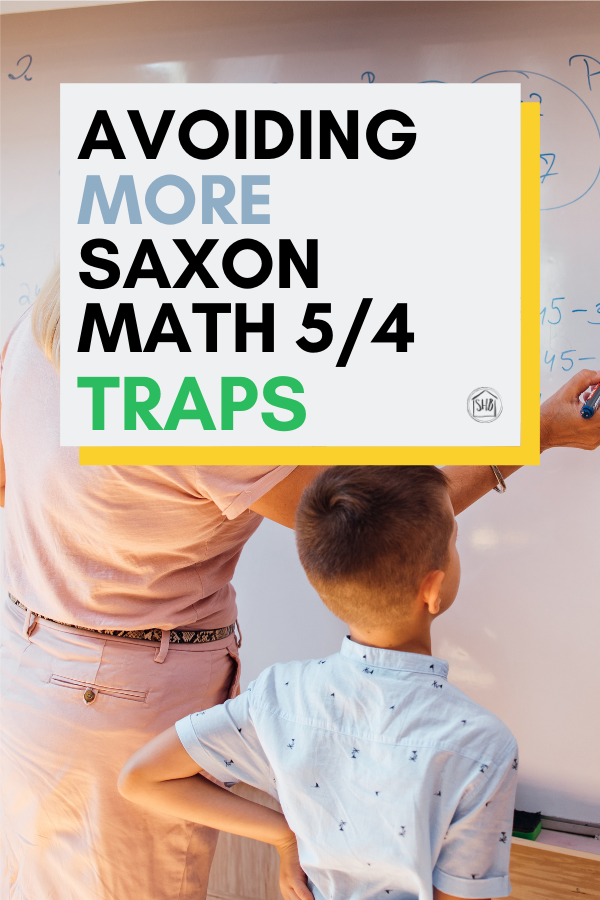
I have a tendency to get a bit long-winded. Hello. This blog is my outlet! I started an article about Saxon Math 5/4 and quickly realized it would need to be a series. If you are just joining the discussion, go here to read the first article – What We Learned in Saxon Math 5/4 – Avoiding Saxon Math Traps.
In that article I talked about the newfound independence our students are gaining when they start Saxon Math 5/4. It is a wonder to behold the growth happening in this year!
This post may include affiliate links. If you click and make a purchase based on my recommendation, I get a small remuneration at no extra expense to you. I only recommend things I use and believe to be a blessing.
I put together a Table of Contents for this post. You can click on the entries to jump to that topic or you can just read as usual.
- Diligence Training in Math
- What a Student Must Overcome to be Successful in Saxon Math 5/4
- Saxon Math Trap #3
- Saxon Math Trap #4
- Avoiding Saxon Math Traps #3 and #4
- Practical Matters
- Timers
- Celebration
- More Saxon Math
Diligence Training in Math
In the last article, I shared our children in Saxon 5/4 are typically on the cusp of the dialectic stage of learning. This stage is full of talking. My daughter is currently finishing up Saxon Math 5/4. She will talk for days! And she is full of questions!
Thus the next lesson Saxon Math taught us in this stage of development is diligence. It takes a lot of personal initiative to become an independent learner. I am amazed at my student doing at her age what I learned much later in my education.
As I mentioned Saxon Math is largely independent. The student is taking instruction for the first time from a math textbook. She is required to stay on task for a longer period of time – without a lot of input from her teacher.
Yes, I am close by and I am encouraging my student to stay on task when necessary, but the encouragement to personal initiative undergirds the Saxon Math curriculum at this stage.
What A Student Must Overcome to be Successful in Saxon Math 5/4
The stretching involved in Saxon Math 5/4 is intense. The math is not the stretch. Thanks to Incremental Development, Saxon Math ought not challenge your well-placed student.
Instead, she will learn the intangibles of being a good student.
In the last article I talked about learning to reason for oneself in order to enter the great math conversation. It’s exciting to watch the growth in this area!
But in order for a student to begin to learn diligence, she has to overcome some pretty major things. We are talking about a maturation process here. Overcoming fidgeting, laziness, zoning out, and all manner of techniques which accompany the big P. Procrastination.
What?! Our kids are typically inborn with some specific function which allows them to avoid staying on task. When our kids are younger, Saxon teaches them to attend to instruction from parent-teachers.
But Saxon Math 5/4 is teaching students to take instruction from a book. What is unique to books is they cannot do anything to grab a student’s attention. They cannot snap their fingers (I am a legendary snapper to get back on task), clear their throats, give the stern look and get the student back on task.
The student must settle himself, muster his mind and do the math – every day. Let me tell you, this is HARD! Not just for fourth and fifth grade students. For 40 year old students, too! It takes discipline and diligence to get through Saxon Math 5/4.
Our students will grow so much this year!
Saxon Math Trap #3
I hear parent-teachers in various Facebook groups encouraging other parent-teachers to lessen the load for their students. Anything from advice to skip a number of lessons until it gets to the “new stuff” to various “testing out” strategies – these are all well intended. But they do not subscribe to the two pronged approach Saxon intended.
I want to make it very clear here: Skipping in Saxon Math is a trap!
Saxon is designed with Constant Meaningful Review in mind. Though it is not a favorite aspect of Saxon Math parent-teachers, I find the parent-teachers who love Saxon Math the most are the ones who do not skip. They see the benefits of the program and watch their students blossom with math confidence and capability.
The pejoratives “drill and kill” are used when talking about the immense amount of review in the Saxon Math curricula. These are misguided. The purpose of Constant Meaningful Review is increasing both speed and accuracy.
The students who do not substantively and sufficiently review the concepts will likely be a step slower than their peers. You might think this doesn’t matter. That’s why you homeschool – to avoid the comparison traps.
I am not suggesting comparison to other students is wise.
Why it Matters
On the contrary, I am suggesting the student who is half a step slower on addition facts, and half a step slower on subtraction facts, and half a step slower on multiplication facts, and half a step slower on division facts is going to be steps behind as the years go on and the levels increase. Not steps behind other students – steps behind where he could be.
I cannot say this enough: we want our students to think math is easy! Not just in the early years, not just in Saxon 5/4, but all the way up to whatever level of higher math they attain to.
Skipping what one deems to be “review” for the student short-changes the student. He doesn’t get time for the concepts to marinate and solidify in his mind. He doesn’t have the opportunity to increase his speed to match his accuracy.
Instead, he is forced to learn only new concepts. That is fine for other math curricula. But it is not the way John Saxon designed his math program.
Saxon Math Trap #4
Ok, here’s another one for you. You might not like my input, but hey, you’re still here, right?
Odds and evens? In Saxon Math 5/4 – this is not a thing.
Another bit of advice I see on in Saxon circles is – “Just do the odds,” or, “Just do the the evens.” This too is a form of skipping, designed to make the math easier for the student. And you know how I feel about skipping, right?
What to do instead? Every problem, every lesson.
I didn’t realize until I had been in a number of conversations about Saxon Math that other math curricula do not have as many problem sets per lesson. So, if you are coming to Saxon Math from another math curricula, I feel for you. It can be a large jump up in terms of work load.
Since my students have been doing Saxon Math from the beginning, they don’t realize Saxon 5/4 is a lot of math work per day. But my 5/4 student is also so well practiced on her math facts that it does not take long to complete a lesson.
The two concepts kind of merge here. If you avoid Saxon Math Trap #3 – not skipping anything, getting constant meaningful review as John Saxon intended – AND you also avoid Saxon Math Trap #4 – not doing odds or evens, doing all the problem sets for every lesson – your student will be able to do her math quickly.
Avoiding Saxon Math Traps #3 and #4
Does it matter if a student can do math quickly? Or does it just matter if he can do it?
I propose it is both.
A student who can do the work and do it quickly will not have to tirelessly train his faculties to be diligent. It will come naturally that the work, done well, will be done quickly.
If you are in Saxon Math, you will have seen this if you do not skip the early lessons of each level. The typical suggestion is to skip 30 lessons and start from there. I suggest if you start at Lesson 30, you may have missed all those days where the math was easy and quick.
You may have also missed out on what one of the real lessons of Saxon Math – diligence.
Practical Matters
You know most of what I am going to say here because I have said it before. But here are my practical (and simple) tips for Saxon Math 5/4:
- Do it all.
- Set a timer.
- Celebrate wins.
Timers
A timer helps a student to know there is an end in sight.
I have a friend who has a son struggling with diligence and staying on task in Saxon Math 5/4. She sets a timer for 15 minutes at a time. She gives her son 4 15 minute math blocks throughout the day. He can go run around the yard in between or get his mind off of math for a bit. 15 minutes is the limit. And he is learning diligence in 15 minute chunks. Someday she may increase it to 20 minutes, 3 times a day. But for now, she is meeting him where he is at, while encouraging his growth in diligence.
Around here we use a timer for Saxon Math 5/4. My student starts her day with the timed math facts. And then she turns the timer cube over to 60 minutes and gets going. She is typically finished with a lesson at the 30-45 minute mark. When she finishes early, I ask her if she wants to do another. Often she will say yes. (She loves math because she is confident in it!)
Celebration
Earlier this year I wrote an article for a friend of mine about Celebratory Homeschooling. We have a generally enthusiastic atmosphere around here. We have fostered a love of learning in many ways. But taking the time to celebrate the beauty of learning is absolutely necessary for us.
One of my kids favorite celebrations is what we call, “Hear ye, Hear ye.” We got it from the early reading curriculum we love. At the conclusion of a hard task or a level of school, I will break out with a shout,
HEAR YE, HEAR YE! (name of student) has just (name of accomplishment)!
Spontaneous celebration takes the form of encouragement to do more, to last longer, to get more “Hear ye, hear ye”s. My kids delight in the learning all the more. The work was hard, the work was long. The celebration ought to be hearty.
More Saxon Math
Man, I can talk about Saxon Math for days – literal days. And I have!
If you are interested in hearing what I think about Saxon Math as I we walk through it and other Saxon Math specific things, I encourage you to subscribe to my Saxon Math list. I have a Guide for Getting Started with Saxon Math in the Early Years. You can have it for free when you sign up to hear from me.

Interested in more about Saxon Math? I hope these articles are a blessing to you:
I have one more post in me about what we learned in Saxon Math 5/4. Stay tuned!














